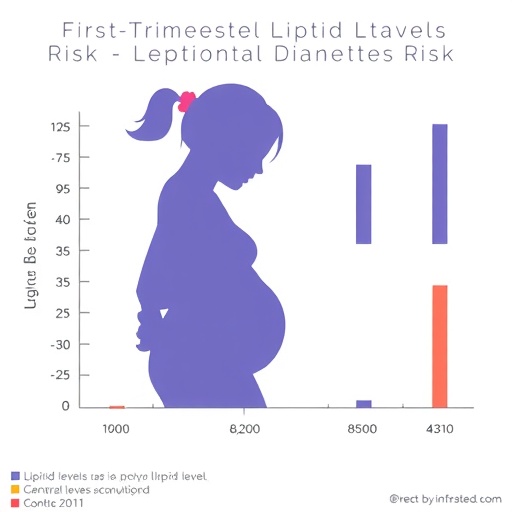In recent years, the increasing prevalence of gestational diabetes mellitus (GDM) has caused alarm among healthcare professionals and researchers worldwide. Notably, studies have focused on understanding the risk factors associated with this condition, particularly during pregnancy. Research published in the journal BMC Endocrine Disorders shines a light on an intriguing aspect: the correlation between non-traditional lipid parameters in the first trimester and the incidence of GDM.
The research conducted by Xiang, Bao, and Pan brings fundamental insights into how lipid metabolism might play a pivotal role in pregnancy. The study meticulously investigates how variations in lipid profiles could serve as early indicators of GDM, a condition impacting not just maternal health but also fetal development. As GDM poses significant health risks, including hypertensive disorders and fetal macrosomia, understanding its predictors is crucial for effective intervention and management.
Gestational diabetes is characterized by glucose intolerance, which is first recognized during pregnancy. The metabolic changes that accompany pregnancy can lead to various physiological alterations, including fluctuations in lipid metabolism. Interestingly, while traditional risk factors such as obesity and family history are extensively studied, this research pivots toward less conventional lipid parameters. The significance of non-traditional lipid parameters lies in their potential to provide a more nuanced understanding of an individual’s risk profile early in gestation.
During the first trimester, profound hormonal and metabolic changes initiate, setting the stage for how the body will handle glucose and lipids throughout pregnancy. Non-traditional lipid parameters, which may include specifics such as lipid ratios or concentrations of certain subsets, have emerged as critical biomarkers in assessing metabolic health. Xiang et al.’s study meticulously chronicled these metrics, assessing their relation to insulin resistance and the potential for developing GDM.
The results unequivocally highlight that certain non-traditional lipid parameters have a statistically significant correlation with the risk of GDM. This revelation emphasizes that metabolic dysfunction, often heralded by lipid dysregulation, could manifest earlier than previously understood. Furthermore, these findings align with the theory that pregnancy as a metabolic state can exacerbate existing conditions or predispositions to diabetes.
Examining the implications of these findings illuminates the potential for early intervention strategies. By identifying women at risk through lipid profiling during the first trimester, healthcare providers can tailor interventions, such as dietary modifications or lifestyle counseling, to mitigate the development of GDM. This proactive approach could transform prenatal care, shifting from reactive measures to preventive strategies, ultimately safeguarding both maternal and fetal health.
The researchers utilized a robust methodological framework, employing rigorous statistical analyses to interpret their findings. The study sample comprised diverse participants, allowing the results to have broader applicability. By leveraging such a comprehensive approach, Xiang et al. contribute significantly to the existing literature on prenatal health and metabolic disorders. Each data point collected offers a glimpse into the complex interplay between lipids and glucose metabolism during a critical period of development.
These insights are particularly timely as public health initiatives strive to reduce the incidence of GDM and its associated complications. Understanding these correlations paves the way for enhanced screening processes and the development of guidelines informing healthcare practices. As health systems evolve, integrating non-traditional lipid parameters into standard prenatal care could become a new norm.
Moreover, the research dovetails with the burgeoning field of personalized medicine. By pinpointing specific risks in individual patients through lipid profiles, personalized healthcare plans can more effectively address unique risk factors. This could lead to better health outcomes and resource allocation within healthcare settings, maximizing the efficacy of preventive measures.
Looking ahead, the implications of Xiang et al.’s research reach far beyond the immediate focus on GDM. As researchers continue to explore the metabolic adaptations during pregnancy, there is potential to uncover further nuances in how maternal health influences offspring development and long-term health outcomes. Future studies may delve deeper into the biochemical pathways linking lipid metabolism with gestational diabetes, enhancing the understanding of not only GDM but also other metabolic conditions.
In conclusion, the correlation uncovered between first-trimester non-traditional lipid parameters and gestational diabetes mellitus represents a significant advancement in prenatal research. As the findings take root, they may spur larger scale studies, encouraging further exploration into the metabolic intricacies of pregnancy. By advocating for early intervention based on lipid profiling, the healthcare community can strive to mitigate the rising tide of gestational diabetes, fostering healthier pregnancies and better futures for mothers and children alike.
In the quest for improved maternal health, the integration of innovative biomarkers such as non-traditional lipid parameters signifies a paradigm shift. This evolving understanding underscores the importance of continuous research and adaptation within clinical practices, ensuring that pregnant individuals receive the best possible care based on emerging scientific knowledge.
Subject of Research: Correlation between the first-trimester non-traditional lipid parameters and the risk of gestational diabetes mellitus in pregnancy.
Article Title: Correlation between the first-trimester non-traditional lipid parameters with the risk of gestational diabetes mellitus in pregnancy.
Article References:
Xiang, J., Bao, R., Pan, Y. et al. Correlation between the first-trimester non-traditional lipid parameters with the risk of gestational diabetes mellitus in pregnancy. BMC Endocr Disord 25, 215 (2025). https://doi.org/10.1186/s12902-025-02024-w
Image Credits: AI Generated
DOI: 10.1186/s12902-025-02024-w
Keywords: gestational diabetes mellitus, lipid parameters, first trimester, prenatal care, metabolic health




